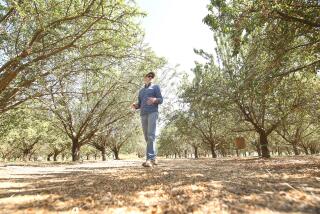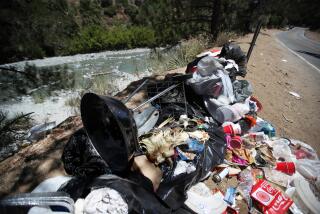Evil Weevils
- Share via
Somewhere at the back of a crowded kitchen shelf, a long-forgotten bag of flour could be alive with insects chewing, spawning, burrowing their way toward a box of rice.
If you don’t believe it, then stop reading. But if you haven’t thought of that flour since you last made Christmas cookies, you may want to continue.
My education in these unpleasant matters began when I noticed what I thought were moths fluttering near our kitchen pantry. Delicate creatures, really: Dove gray, a mere quarter-inch long, they lifted softly when disturbed by light or an opening door, slow-moving, easy to kill.
Slow in my own way, I wondered idly why moths would be hanging around where there were no sweaters or winter blankets to destroy. I waved them away or crushed them in a tissue, switched off the light and closed the pantry door.
Gradually, a dim suspicion stirred: If they weren’t after wool, did they feed on something else?
The next day at work I went straight to a colleague who has been able to answer any question I’ve ever asked about anything related to food.
Weevils, she said, with swift and unstinting certainty. Something you bought was infested with weevils. They could be anywhere now. They could be everywhere. Dump everything not in a bottle or can. Whether you can see bugs or not. Whether the package has been opened or not. Whether you just bought it or not. Don’t think about the money or the waste. Get everything off the shelves, cart it straight to the trash, tonight. Then wipe every bottle, every can, every surface with a bleach solution.
Oh yeah? And then should I scrub myself down with lye and burn my clothes?
She was advising the destruction of probably $100 worth of perfectly good food. Well, food anyway. It’s perfect goodness was now in doubt.
With the hoarding habits of a lifetime, I kept a pantry worthy of a survivalist, a showcase of prudent self-reliance. Row after tidy row of nonperishable foodstuffs, stockpiled for a quick midweek side dish or a Y2K meltdown.
Food as security blanket, expressed in boxes of rice, pasta, tabbouleh and couscous, many in multiples purchased with coupons. Economy packages of kid-pleasing macaroni and cheese. Five or six kinds of cereal. Backup boxes of brownie mix, cake mix, croutons and bread crumbs. One shelf just for baking staples: flour, cornmeal, sugar, powdered sugar, brown sugar, salt (Do weevils like salt?). Another for snacks: cookies, crackers, pretzels. (Luckily, the spices were stored elsewhere. Weevils, it turns out, love spices. Especially paprika. Maybe they’re Hungarian.)
Some of my pantry items had been opened and shoved back on the shelf. But most were unopened, and many had been there for months. Even years. Was I really supposed to throw it all out?
That evening, in deep denial, I approached the pantry with the wariness of a hazmat specialist: rubber gloves up to the elbow, flashlight, heavy-duty plastic garbage bag, bleach and sponge.
Slowly, I started taking one package at a time off the shelf, holding it at arms’ length, searching for clues with no idea what to expect: A network of tunnels chewed through cardboard packaging? Little piles of flour dust in the back corners? Larvae sleeping in the Cheerios? Adult moths beating their tiny wings inside a pasta prison?
As it turned out, the Trojan horse was surprisingly easy to find: a box of Arborio rice that looked like innocence itself. Brought home from a store that charges premium prices for organic peace of mind. And there, behind the cellophane window, was my organic bonus--five or six clearly visible gray bugs chowing down on weevil risotto.
Disgust replaced denial. I started pulling boxes and bags off the shelves, following a trail of spreading infestation. Here, in the unopened and forgotten paper bag of cornmeal. There, in the raisin bran opened but ignored for months. Crawling over the ice cream cones my 10-year-old hadn’t thought about since late last summer.
The cones sent me over the edge. I stopped checking closely or caring whether packages had been opened. Box after box went into the bag. Enough couscous for a Moroccan holiday. Pasta for the multitudes. Tabbouleh that had been waiting months for tomato season.
I tried not to think about the money, but as one garbage bag filled and it became clear that another would be needed, I vowed never again to buy in bulk. “Eat as we go” would be our motto. Lean and mean.
And another thing: Never again would I assume unopened meant unspoiled. Apparently no box could be closed tightly enough, no bag crimped securely enough. I ran the flashlight over a newish cellophane bag of orzo and half a dozen winged creatures stirred to life. Maybe they were inside when I bought it, or maybe they migrated from the rice. My bet was still on the rice.
An hour and two bulging garbage bags later, the cupboard was bare. A pyramid of cans and a scattering of bottled oils and vinegars stood to one side, waiting to be bleached. It was after 10. I was tired, discouraged, in no mood for more trouble.
I pause now to add an admission of idiocy that made this a truly memorable evening. Among the few survivors scattered about the kitchen floor was a clear plastic canister of wild rice. Now, I don’t like wild rice all that much and couldn’t even remember the last time I’d cooked it. I’d kept it mostly for its decorative qualities and because it’s expensive. I thought it added a little tone.
Ah well. Good time to let it go, infested or not. But for some reason, rather than empty the canister in the garbage bag, I dumped the whole thing, maybe two cups’ worth, down the sink and turned on the disposal.
I can still see the rich grains spiraling darkly down the drain, churning and churning out of sight until, suddenly, the disposal’s motor choked. I flipped the switch on and off until the kitchen began to fill with the smell of burning gears. I got on hands and knees and cranked the unit with an Allen wrench; no go. I fetched the rubber plunger, which brought up some nasty brown gunk without budging the clot.
So there I was, up to my elbows in rubber gloves, food all over the floor, a bucket of bleach solution ready to scrub down walls and shelves, with no working sink.
The situation called for desperate measures. As it happened, desperately stupid measures. I hit on the strategy of pouring boiling water down the drain, to soften the sludge.
It was one of those moments you’d give anything to take back even as it’s ticking past. The boiled water did what boiled water always does to uncooked rice. The grains swelled nearly to bursting inside the pipes. The disposal, once merely clogged, was now the most solid part of the house.
Let’s pass up further sordid details. The garbage bags were dragged to the alley. The walls and shelves were punished with bleach. By midnight, the few cans and bottles were re-shelved, looking lost in the near-empty cupboard. I felt like Old Mother Hubbard. And I was in need of a plumber.
For the next few days, I opened the pantry door expecting to be assaulted by a flying wedge of weevils. But apparently they were decimated. Only stragglers appeared, crawling out to wave tiny white flags, flying feebly in circles. Gradually, even these dwindled. Sometimes days would pass without a sighting.
I was ready to declare victory but not to relax my vigilance. I adopted new shopping habits, buying only what I planned to fix that week. I passed up products packaged only in cardboard in favor of those with sealed bags inside boxes. Whatever wasn’t eaten all at once, like breakfast cereals or crackers, was transferred straight into zipped plastic bags as soon as it was opened. Staples like flour and rice were inspected as soon as I got them home, then stored in rubber-rimmed canisters. Kitchen life resumed.
But one night recently I reached for some rice. Inside the tightly lidded jar, at least a dozen winged insects stirred. I’m calling the exterminator.
More to Read
Eat your way across L.A.
Get our weekly Tasting Notes newsletter for reviews, news and more.
You may occasionally receive promotional content from the Los Angeles Times.










